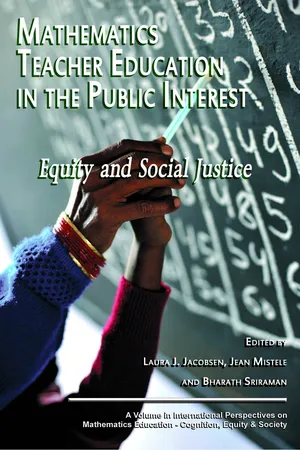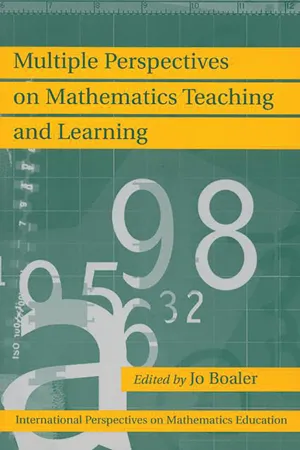Technology & Engineering
Maths Identities
Maths identities are mathematical equations that are true for all values of the variables involved. They are used to simplify and solve mathematical problems, and are fundamental in various engineering and technological applications. These identities include trigonometric identities, logarithmic identities, and algebraic identities, and are essential for solving complex mathematical problems in engineering and technology.
Written by Perlego with AI-assistance
Related key terms
1 of 5
4 Key excerpts on "Maths Identities"
- Frank K. Lester(Author)
- 2005(Publication Date)
- Information Age Publishing(Publisher)
Notions of identity are included in understanding not only be-cause educators want students to like mathematics for the purposes of engagement and motivation over time but also because developing a particular stance towards the mathematics is part of understanding the mathematics (National Research Council, 2002). The relationship students develop with mathematics—how they see themselves in relation to the mathematics— influences how they participate, how they make sense of the mathematics, and the different ways they persist. This is all a part of understanding mathematics. This places one’s mathematical identity not as something peripheral to doing mathematics but as central. Gee (2001) described identity as “being recog-nized as a certain ‘kind of person’ in a given con-text.” Wenger (1998) described identity as the “piv-ot between the social and the individual” (p. 145). Both would argue that identities are constantly being formed and re-formed in the dialectic between social structures and individuals’ lived experiences. Identi-ties reflect histories of engagement in sociocultural communities, institutions, and practices. As Stuart Hall (1996) explained, “[This view] accepts that iden-tities are never unified and, in late modern times, in-creasingly fragmented and fractured; never singular but multiply constructed across different, often inter-secting and antagonistic, discourses, practices, and positions” (p. 4). These conceptions of identity illustrate the impor-tance of thinking about classrooms as places where identities are constructed and reconstructed through discourse. In many mathematics classrooms the iden-tities constructed through discourse practices perpet-uate beliefs about who is mathematically literate, and often this construction differentiates students on ra-cial lines (Boaler, 2002; Martin, 2000).- Laura J. Jacobsen, Jean Mistele, Bharath Sriraman(Authors)
- 2017(Publication Date)
- Information Age Publishing(Publisher)
I conclude with a final discussion of the pertinence of this study to the research literature. STUDENT IDENTITY IN THE MATHEMATICS CLASSROOM In this study, a theoretical frame was used that integrates theories of diver-sity and equity with social constructivism to examine features of two stu-dents’ nascent mathematical identities based upon their solutions to mathematical tasks. In the review of video data collected as part of a for-mative assessment project, I became interested in considering how middle school students think about themselves in relation to mathematics; that is, their “mathematical identity” (Martin, 2000). The notion of mathematical identity typically considers issues often considered in the past research lit-erature related to “affect,” such as students’ persistence and interest in mathematics and their motivation to engage in learning mathematics (Cobb, Gresalfi, & Hodge, 2009). Recent research in mathematics educa-tion has expanded the notion of mathematical identity to include the study of the relationship between learning and the larger learning environment of the classroom (Boaler, 2002; Boaler & Greeno, 2000; Cobb, Gresalfi, & Teacher Pleasing and Student Identity 41 IAP PROOFS © 2012 Hodge, 2009; Cobb & Hodge, 2007; Martin, 2000; Nasir, 2002; Nasir & Hand, 2008). Similar to Martin’s (2000) conceptual framing of the intrapersonal level of identity, the two constructs of the interpretative scheme that Cobb, Gresalfi, & Hodge (2009) used in their study of students’ mathe-matical identity were normative identity and personal identity. Normative identity concentrates on the group’s views on the activities associated with learning mathematics in the classroom and the level to which they iden-tify with these activities, while the personal focuses on the individual stu-dent’s views on classroom-level mathematics learning and the extent to which the student resists such learning.- eBook - ePub
- Harry Daniels(Author)
- 2012(Publication Date)
- Routledge(Publisher)
Furthermore, the idea, at the heart of the mathematics school curriculum all over the world, that mathematical knowledge learned in the abstract in school can be applied by students outside school in everyday problems, the notion of transfer, is comprehensively challenged by the idea that knowledge is situated, not carried in decontextualized concepts in the mind. Differences between within school and out-of-school competences were also challenged by Nunes et al. (1993). At the same time, the association of ‘being good at mathematics’ with being a geek or nerd, or at least as being unusual and different, as experienced by so many of us when mentioning our mathematical proclivities at parties, raises questions of what it is like to be a mathematician, or how one comes to be one, when so many people have such negative experiences of learning mathematics at school. Hence here too the notion of identity seems an obvious place to examine learning. It matters enormously in mathematics of course, since it is unreasonably significant for students' future life possibilities. In the UK, for example, one cannot gain a place in university for the one-year postgraduate teacher education course, even if one is to teach art at secondary school, without certification in mathematics. In France the highest level of mathematics needs to be taken in the baccalauréat if one is to gain a place at the top universities, once again even if mathematics scarcely figures in the course. Mathematics is seen, unjustifiably I suggest, as a general measure of intelligence and capacity. Bernstein's last book (2000) was entitled Pedagogy, Symbolic Control and Identity, emphasising the importance of the notion for him - Jo Boaler(Author)
- 2000(Publication Date)
- Praeger(Publisher)
The mathematics classroom may be thought of as a particular social setting—that is, a figured world—in which children and teachers take on certain roles that help define who they are. Holland and associates (1998) use the term “positional identity” to refer to the way in which people comprehend and enact their positions in the worlds in which they live. This builds on their theory that identities develop in and through social practice. They acknowledge that identities are centrally related to structural fea- tures of society such as ethnicity or gender but draw attention to the specific prac- tices and activities situated in “worlds” such as academia, romance, or local politics. “Positional identities have to do with the day-to-day and on-the-ground re- lations of power, deference, and entitlement, social affiliation and distance—with the social-interactional, social-relational structures of the lived world” (Holland et al., 1998, pp. 127–128). Another aspect of identity they describe is the “space of authoring,” which is encapsulated by the notion that “the world must be an- swered—authorship is not a choice” (1998, p. 272). This idea is concerned with the responses individuals give, with human agency, and with improvisation. The possi- bility and forms of authoring that are created in different mathematics environ- ments, among learners who are often conceived as “receivers” of education (Corbett & Wilson, 1995), is an important question that will be pursued in this chapter. We consider students’ talk about their mathematics learning in their interviews with us as reports of their perceptions and understandings of the figured social worlds of mathematics education in which they participated as learners. The stu- dents’ descriptions may also be taken to indicate their positionings in the ecologies of participation in practices of mathematics education and reflections of their authoring of identities as learners and performers of mathematics.
Index pages curate the most relevant extracts from our library of academic textbooks. They’ve been created using an in-house natural language model (NLM), each adding context and meaning to key research topics.



